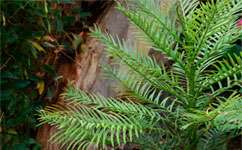Araucarias gauge ancient levels of carbon dioxide

One way of telling how much carbon dioxide was in the atmosphere in the past is by counting pores (or stomata) in leaves – the tiny openings plants use to absorb CO2 and lose water. It may seem far-fetched, but plants tend to decrease the number of pores when the atmospheric CO2 is increased.
'With this observation it is possible to use the number of stomata on the leaves of fossil plants to calculate the concentration of atmospheric carbon dioxide in which those leaves developed,' explains Matthew Haworth, now based at the Istituto di Biometeorologia in Florence, Italy.
The relationship between number of stomata and CO2 varies from species to species and can be determined by counting the pores of plants grown in the lab, under different amounts of CO2. Another possibility is to count the stomata of leaves preserved in herbariums over the past 200 years and then compare them to recorded atmospheric CO2 concentrations.
This so-called stomatal method 'works beautifully over the last 1.5 million years where you have the same species living as today,' says Haworth. The method is relatively cheap and offers a good time-resolution, which is important to understand 'rapid perturbations to the climate system, such as mass extinction events or disruptions to the global carbon cycle,' he adds.
The catch is that most plant species stop decreasing the amount of stomata if the CO2 concentration is above 400 parts per million. This is known as the ceiling response and 'really limits the effectiveness of the technique during periods of high concentrations of carbon dioxide, which are obviously the periods we are most interested in to compare with current rising CO2,' says Haworth.
And this is where araucarias come in handy.
Araucarias nowadays are not very common, but 200 million years ago they represented a large chunk of the world's forests. These trees evolved in a period when the concentration of CO2 in the atmosphere was a lot higher than it is today and for that reason araucarias are good candidates to gauge the levels of CO2 in the atmosphere during the age of dinosaurs.
However, not much work has been done to understand how the number of stomata in araucaria leaves relates to CO2 concentration. To do this, Haworth and his team counted the stomata in leaves preserved in herbariums 'to give us an idea of how these species respond to CO2 concentrations below current ambient levels and also over longer timescales,' he says.
Additionally, the team grew three species of araucaria (Araucaria bidwillii, Agathis australis and Wollemia nobilis in a controlled environment 'to see how these ancient conifers respond to CO2 levels way above current ambient,' Haworth says.
Working with the Wollemia araucaria was especially significant. This species was discovered near Sydney, Australia in 1994 when scientists thought it was extinct for 15 million years. 'It was really exciting that I got to see the herbarium specimens of this conifer and that we were able to grow them,' says Haworth.
The results, published in Oecologia, suggest that unlike most plants araucarias don't show a relationship between number of stomata and CO2 below the level of 400ppm. However, when the CO2 concentration is above this threshold, 'the araucarias reduced their stomatal density by 11 to 25 per cent, which is a very significant decrease,' Haworth says.
This means that araucarias do not show the same ceiling effect as other plants. In practice the results show that araucarias can step in and be useful gauges of past CO2 levels, especially during times when CO2 concentration was higher than today.
This story is republished courtesy of Planet Earth online, a free, companion website to the award-winning magazine Planet Earth published and funded by the Natural Environment Research Council (NERC).
More information: Matthew Haworth, et al. The stomatal CO2 proxy does not saturate at high atmospheric CO2 concentrations: evidence from stomatal index responses of Araucariaceae conifers. Oecologia, doi:10.1007/s00442-011-1969-1
Provided by PlanetEarth Online
















